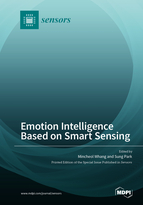Emotion Intelligence Based on Smart Sensing
A special issue of Sensors (ISSN 1424-8220). This special issue belongs to the section "Physical Sensors".
Deadline for manuscript submissions: closed (31 October 2022) | Viewed by 52033
Special Issue Editors
Interests: emotion recognition; emotion intelligence; social emotion; social neuroscience; emotional neuroscience; brain computer interface; human computer interaction
Special Issue Information
Dear Colleagues,
Emotion intelligence is important in determining human relation in community, organization, and society in daily life. Emotion intelligence is to how well emotion is recognized and how well emotion is expressed. Emotion is individual, while social emotion is interdependent. Digital environments such as VR, AR, and robot require the ability to track and recognize emotion quantitatively in real time during emotion interaction among more than two persons. Therefore, emotion machines having emotion intelligence have been studied to implement a digital society.
Emotion has been quantified from sensing facial expressions, gestures, and physiological signals such as EEG, ECG, EDA, and other signals. In addition, emotion would be more accurately recognized with considering the emotional context, including situation at spatiotemporal variability, congruency of implicit and explicit response, consistency of human action, and human relation in society.
Human emotion is not only the short-time response but long-time response having patterns and trends in daily life. Lab studies of sensing emotion should extend to smart sensing, which monitors and tracks emotion variation with predictable pattern.
This Special Issue is to explore empirical studies of emotion mechanisms, qualitative and quantitative measurements of emotion, recognition of the emotion context, and application of emotion and to overcome engineering problems for better accuracy of emotion recognition.
Prof. Dr. Mincheol Whang
Prof. Dr. Sung Park
Guest Editors
Manuscript Submission Information
Manuscripts should be submitted online at www.mdpi.com by registering and logging in to this website. Once you are registered, click here to go to the submission form. Manuscripts can be submitted until the deadline. All submissions that pass pre-check are peer-reviewed. Accepted papers will be published continuously in the journal (as soon as accepted) and will be listed together on the special issue website. Research articles, review articles as well as short communications are invited. For planned papers, a title and short abstract (about 100 words) can be sent to the Editorial Office for announcement on this website.
Submitted manuscripts should not have been published previously, nor be under consideration for publication elsewhere (except conference proceedings papers). All manuscripts are thoroughly refereed through a single-blind peer-review process. A guide for authors and other relevant information for submission of manuscripts is available on the Instructions for Authors page. Sensors is an international peer-reviewed open access semimonthly journal published by MDPI.
Please visit the Instructions for Authors page before submitting a manuscript. The Article Processing Charge (APC) for publication in this open access journal is 2600 CHF (Swiss Francs). Submitted papers should be well formatted and use good English. Authors may use MDPI's English editing service prior to publication or during author revisions.








